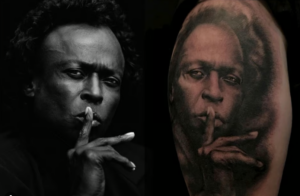
The issue of fair use has been a hotly contested topic for decades. Fair use protects the idea that art often builds off of other art. It can be difficult to strike the proper balance between protecting an artist’s right to their art and honoring the collaborative nature of creative expression. Song parodies are one common example of the types of art protected by fair use.
The concepts behind fair use trace their roots back to the 1800s, but fair use itself was not codified into U.S. law until the Copyright Act of 1976, 17 U.S.C. § 107 (the Act). Even after the Act, fair use was characterized by the U.S. Supreme court as an affirmative defense until Lenz v. Universal Music Corp. in 2015.
In 2021, a lawsuit was filed under the Act against celebrity tattoo artist and businesswoman Kat von Drachenberg, more commonly known as “Kat Von D”. You may know Von D from her show LA Ink. The issue was with a tattoo done by Von D in 2017. The tattoo was inspired by a 1989 photo of jazz legend Miles Davis, taken by plaintiff Jeffrey Sedlik. A photo showing the tattoo, with the image of Miles Davis next to it, was posted to Von D’s social media accounts, where she has millions of followers.
Sedlik’s claim is Von D illegally reproduced the copyrighted photo and used the reproductions for brand promotion. A jury looked at whether the image and the reproductions were ‘substantially similar.’ The tattoo itself, the sketch Von D made preceding the tattoo, and each social media post depicting the tattoo were considered reproductions for purposes of the case.
Consideration was also given to the amount of social media engagement drummed up by the posts and whether Von D profited from the reproductions. To this point, Shubha Gosh, an IP professor at Syracuse University posed the question, “did [Von D] take money that otherwise would have gone to the plaintiff’s pocket?” Von D’s attorney emphasized that she did not mass produce the images or make any attempt to cash in on them. Von D posts many images of her work on her social media accounts. In her view, this image was no different.
On January 26th, the jury verdict was announced in favor of Von D, finding that her reproductions were not substantially similar to the original photograph, and that the reproductions all fell under the doctrine of fair use. Sedlik’s attorney has said that Sedlik plans to appeal the decision, claiming that the jury verdict renders “no one’s art… safe.”
Many tattoo artists use reference art without securing the rights to it. Von D said she considers work, like her Davis tattoo, a form of fan art, which is protected under fair use. The questions posed by this case (and possible appeal) could change the landscape of the tattoo industry forever.
For help with your small business’s intellectual property needs, contact the clinic at businessclinic@elon.edu.